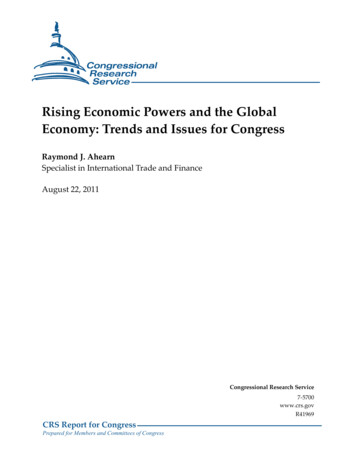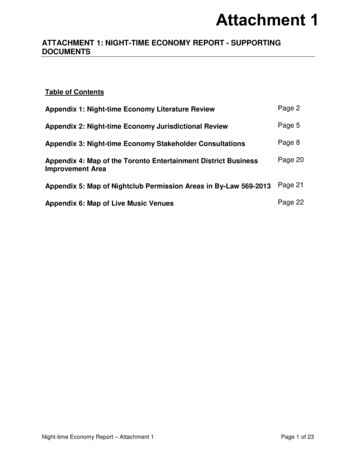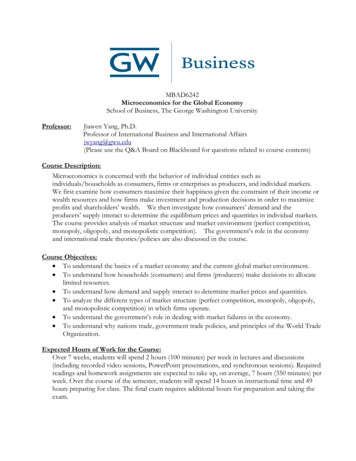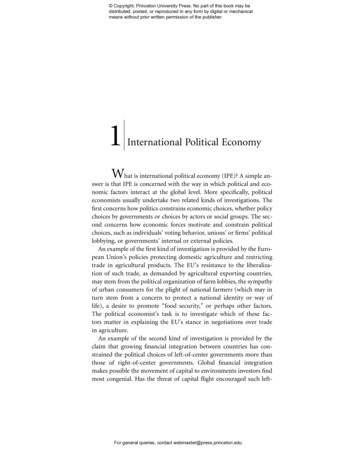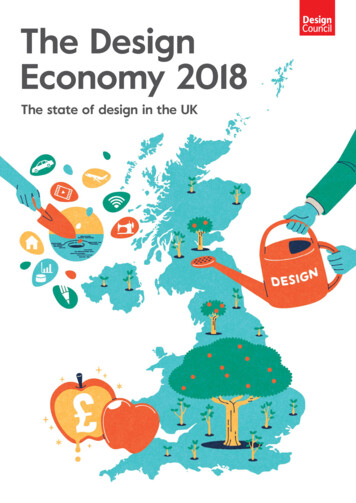
Transcription
The DesignEconomy 2018The state of design in the UK
Design Economy 2018ForewordChurchill's war government established the Council for Industrial Design in1944 to support the economic renewal of the nation. The country turned todesign to rebuild, innovate and instigate growth. Our role now as DesignCouncil is to make life better by design. So as the country faces seismiceconomic challenges and change, it is time to once again turn to design.The UK is responding to the fourth industrial revolution, whilst tacklingstagnant productivity, unequal growth across its regions and automation'sincreased impact on living conditions and job security. It must also establisha new vision for its place in the world – negotiating an exit from theEuropean Union and developing new trading partnerships.Yet with these challenges come opportunities. Innovation and technologicalchange – from 3D printing to artificial intelligence – offer hope for abrighter future. They bring the prospect of business growth and highervalue jobs that can transform the economy across the UK. As advancedeconomies such as the UK adjust to technological and economicdevelopments, commentators from Nesta1 to the World Economic Forum2predict that demand will grow for skills which are difficult to automate.Our 2017 research found that designers have these attributes, typified bytheir emphasis on interpersonal skills such as operations analysis and socialperceptiveness, and cognitive abilities such as visualisation and thinkingcreatively.3Design Economy 2018“ Design and designskills are at theheart of the fourthindustrial revolution.They give us thetools to respond tothese unprecedentedchallenges, andinstigate the growth,innovation and jobsthat will drive theUK’s global future.”¹ Nesta (2017) The Future of Skills: Employment in 2030 [online]² World Economic Forum (2016) The 10 Skills You Need to Thrive in the Fourth Industrial Revolution [online]³ Design Council (2017) Designing a Future Economy: Developing design skills for productivityand innovation [online]23
Design Economy 2018Design and design skills are at the heart of the fourth industrial revolution.They give us the tools to respond to these unprecedented challenges,and instigate the growth, innovation and jobs that will drive the UK’sglobal future.Good design puts people first. It uses creativity to solve problems,challenge thinking and make lives better. Designers operate acrossthe whole economy. They shape the built environment, the digital worldand the products and services we use, creating better places, betterproducts, better processes and better performance.We define this activity as ‘the design economy’ – the value createdby those who use design in a wide variety of industries. This includesdesigners in design industries (eg, digital design or animation), other rolesin design industries (such as administration, finance and distribution on thebasis they are supporting the main design function), as well as designers inother sectors of the economy, such as in banks, consultancies, automotiveor aerospace companies.Design Economy 2018Key findingsThe Design Economy 2018 provides acomprehensive overview of the stateof design in the UK and is packed fullof data and new evidence on design’svalue and impact.The Design Economy 2018 builds on our 2015 research, a world firststate-of-design report. It demonstrated how design drives growth andinnovation to create significant value for the UK economy. Design economystudies have since been replicated by others for the City of Atlanta andNew Zealand, with more in the pipeline. Our 2018 report explores widerquestions arising from our original research and connects to the emergingeconomic challenges facing the UK. It examines in greater depth theeconomic impact of design on regional and local economies, and providesa deeper analysis of the types of businesses and people who are using,working with and benefiting from design.Our 2018 report shows that design is growing – both in value and demand.However, there is still room for improvement, with many businesses, areasof the country and people continuing to miss out on the benefits.Our report draws on in-depth analysis of data from the Office for NationalStatistics (including the Annual Business Survey and Annual PopulationSurvey) undertaken on behalf of Design Council by the Enterprise ResearchCentre. A unique survey of over 1,000 UK businesses about their use ofdesign, delivered by BMG Research, complements this. Additionally, BOPConsulting compiled in-depth case studies of seven firms who eitheroperate in design-intensive industries or are exemplars of how non-designfirms can use design to achieve better outcomes.We hope you enjoy reading this research and will work with us to deliveron the recommendations and help the UK economy turn to designonce more.Sarah Weir OBECEO, Design Council45
Design Economy 2018Design Economy 2018The value of designto the UKThis size renders it comparable to the hospitalitysector (1.6 million employees) and the logisticssector (1.5 million).The scale and scope ofthe UK design economyThe UK has transitioned from an economypowered by might and machine to oneincreasingly powered by services andtechnology. Design has played a key role inthese developments, evolving with economicshifts, boosting productivity and instigatinginnovation4 – from the industrial designers thatpioneered post-war aviation to those designingrobots and artificial intelligence today. This 2018report focuses on the value created for the UKeconomy by designers operating either in designindustries or outside in wider business sectors.5It demonstrates the continuing importance ofdesign to UK growth and future economic sectors:We also found there are 78,030 design-intensivefirms operating in the UK (2017). This represents a63% increase in design-intensive firms since 2010(compared to a 3.7% increase for businessesacross the UK as a whole).It is within the context of the fourth industrialrevolution and the predicted growth in demandfor design skills that we sought to betterunderstand the qualifications, pay and workingpatterns of those operating within the designeconomy and where in the country design ishaving an impact.1. Design is high value and growing:The design economy generated 85.2bn ingross value added (GVA) to the UK in 2016.This is equivalent to 7% of UK GVA and equivalentto the size of the distribution, transport,accommodation and food sectors6. This valuehas grown 10% since our last report, outstrippingthe UK growth rate during the same period(7% between 2014 and 2016). Over the longerterm, between 2009 and 2016 the designeconomy grew by 52%, spreading far beyond thecreative industries and across the UK economy.Designers operating in non-design industriessuch as aerospace, automotive and bankingcreated the majority of this value (68%).2. The scale of the design economy is growing:In 2016, there were 1.69 million people employedin design roles. This represents growth of 6%since our last report, equivalent to 99,604 newjobs (compared to a UK average of 4% since2014). If the design economy were one sector,this would make it the ninth largest employmentsector in the UK.3. The design economy has a ‘long tail’:A 'long tail' characterises design-intensivesectors, with many small firms compared to afew larger firms. The growth in firm numbers isbeing driven by a large number of start-ups, themajority of which (60%) survive for more thanthree years, which is higher than the average forsmall and medium enterprises (SMEs) across thecountry (44%).74. Designers are highly productive:We found designers were 29% more productivethan the average UK worker, each delivering 50,328 in output (GVA per worker, 2016),compared to 39,111 across the rest of theeconomy. This figure is higher than thoseworking in ‘professional, scientific and technicalactivities’ ( 50,064) which incorporatesaccounting and auditing activities, and researchand experimental development in the naturalsciences, among others.85. Design is increasingly digital:Digital design now accounts for just over onein three design roles (2016) and is the fastestgrowing part of the design economy. Firms inthis sector experienced an 85% growth inturnover between 2009 and 2016, reflecting thegrowing importance of digital design to the UK.This demand also extends abroad: the digitaldesign subsector is the UK’s most valuable designexporter, delivering 27.9bn in design-influencedexports in 2015, which is equivalent to 58% of thevalue of all design exports.Design Council (2018) Understanding Design-Intensive Innovation: A literature review [online] In The Design Economy 2018 we have focused our analysis on those 23 Standard Occupational Classification (SOC) codesthat were previously identified as being design occupations. This means figures for GVA and employment are naturallylower than those reported in our 2017 Designing a Future Economy report, which identified 40 SOC codes that usedesign skills, including many non-design occupations.6ONS (2017) Regional gross value added [online]7ONS (2017) Business demography, UK: 2016 [online]8ONS (2018) Labour productivity: region by industry [online]456Our analysis shows that designers have higherlevels of formal qualifications than the averageUK worker and are, in many cases, also morehighly paid. This signifies the demand for designskills, knowledge and services. Building on thisdemand presents a unique opportunity for thedesign economy.However, our analysis also highlights keychallenges. The south-east of England continuesto benefit disproportionately from high valuedesign occupations and innovation. With 1.69million people currently employed in the designeconomy, there is room for growth. Design largelyoperates in higher value sectors, impacting somelocal economies more than others and has a lessdiverse workforce.As such, much of the design economy’s potentialto contribute to future UK growth remainsuntapped, and there is an emerging risk ofgrowing inequality between firms accessingdesign and those that do not, as well asbetween people who have such skills and thosewho don’t.6. Designers are highly qualified:Across the design workforce 57.1% of workers helda degree as their highest level of qualification(in 2016), compared with a UK average of 34%.This indicates that not only are designers stayingin formal education longer, but also that thereis a growing expectation amongst employers fordesigners to be educated to this level.7. Designers are well paid:Our research shows that in 2016, the averageweekly salary for workers in the design economywas 548, only slightly higher than the UKaverage weekly wage of 539 that year.However, this figure is depressed by the wagesof support roles in design industries, and rises to 609 per week for designers in design industries.Digital designers earn the most with an averageweekly wage of 757. Coupled with the higherlevels of formal qualifications in these sectors,this suggests these skills have a high perceivedvalue to these firms.8. Design has a diversity challenge:– Ethnicity: The design economy employs aslightly higher proportion of people fromBlack, Asian and Minority Ethnic (BAME) groupsthan are employed in the wider UK economy(13% compared with 11%), and this figure hasimproved since our previous analysis (11.4%).However, BAME designers are least likely to bein senior roles, accounting for only 12% of alldesign managers.– Gender: 78% of the UK’s design workforce ismale. This is higher than the percentage ofmen in the wider UK workforce (53%). This isalso despite women making up 63% of allstudents studying creative arts and designcourses at university. The overall ratio is skewedby the male dominated subsectors of productand industrial design (95%), digital design (85%),and architecture and built environment (80%).Even when employed in design, women earnless. For example in the multidisciplinary designsubsector, women working as product, clothingand related designers earn 18.3% less than menin that subsector despite making up nearlytwo-thirds of that design subsector (64%).Women are also less likely than men to be insenior roles, with only 17% of design managersbeing female.7
Design Economy 20189. Design can generate significant value forlocal and regional economies:London remains the powerhouse of UK design,with almost one in three design firms nowbased in the capital, as well as one in fivedesign workers. This has become moreconcentrated since our last study. Yet this studyalso shows that over the past few years mostUK regions have also experienced growth inthe GVA generated by designers in their area.This growth appears to be driven by acombination of two things. The first driver islocalised design specialties such as craftdesign in the West Midlands (eg, the potteriesin Stoke-on-Trent). Outside London and thesouth-east, the West Midlands, along with thenorth-west, has experienced the most significantgrowth in design GVA since 2010 (83% and28.5% respectively).Design Economy 2018The second key driver is a growth in clustersof multidisciplinary design firms – covering firmsundertaking specialised design activities rangingfrom sustainable design and industrial designto interior design, among others. These arestrongest in London and the south-east, withthe multifaceted nature of the design economiesin these regions a strength not always replicatedelsewhere.The design economyin a global UKDesign specialism sets the UK apart fromglobal competition. But whilst the demand forUK design is growing, international competitorsare also growing their design exports rapidly.Capitalising on design’s potential to increase UKgoods and services exports is more importantthan ever as the UK exits the European Union.10. UK designed products and services arein demand and recognised across the world:We found that in 2015, the total value of exportswhere design had made a key contribution was 48.4bn, represe
in design industries (such as administration, finance and distribution on the basis they are supporting the main design function), as well as designers in other sectors of the economy, such as in banks, consultancies, automotive or aerospace companies. The Design Economy 2018 builds on our 2015 research, a world first state-of-design report. It demonstrated how design drives growth and


